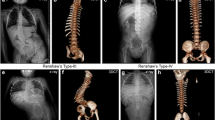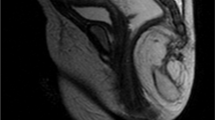Abstract
Purpose
Sacral abnormalities range from missing the coccyx, a few sacral vertebrae, or hemi-sacrum, to complete absence with fused iliac bones. The purpose of this study was to review the association between sacral agenesis and fecal incontinence to help inform patient prognosis.
Methods
A retrospective review was performed of patients who presented for bowel management due to sacral agenesis at a tertiary care children’s hospital between 2016 and 2017 (n = 10). Data collection included: gender, time of diagnosis, sacral ratio, and associated anomalies. Patients with anorectal malformation and sacrococcygeal teratomas were excluded.
Results
Four patients were female. Seven patients had a delayed diagnosis ranging from 22 months of age to 9 years. Most common symptoms included failure of age-appropriate toilet training and severe diaper rash. The sacral ratio was zero (6), 0.3 and 0.4 (2), and hemi-sacrum (2). Associated anomalies were present in five patients.
Conclusion
Sacral abnormalities should be suspected in patients who present with early severe diaper rash and those who fail to toilet train. An abdominal radiograph can evaluate the sacrum, when the sacral ratio is 0.4 or less, parents should be counseled regarding fecal incontinence and neurogenic bladder.

Similar content being viewed by others
References
Renshaw TS (1978) Sacral agenesis. J Bone Joint Surg Am 60(3):373–383
Andrish J, Kalamchi A, MacEwen GD. Sacral agenesis: a clinical evaluation of its management, heredity, and associated anomalies. Clin Orthop Relat Res. 1979(139):52–57
Emami-Naeini P, Rahbar Z, Nejat F, Kajbafzadeh A, El Khashab M (2010) Neurological presentations, imaging, and associated anomalies in 50 patients with sacral agenesis. Neurosurgery 67(4):894–900 (discussion)
Macedo M, Martins JL, Freitas Filho LG (2004) Sacral ratio and fecal continence in children with anorectal malformations. BJU Int 94(6):893–894
Morera C, Nurko S (2003) Rectal manometry in patients with isolated sacral agenesis. J Pediatr Gastroenterol Nutr 37(1):47–52
Borrelli M, Bruschini H, Nahas WC, Figueiredo JA, Prado MJ, Spinola R et al (1985) Sacral agenesis: why is it so frequently misdiagnosed? Urology 26(4):351–355
Wilmshurst JM, Kelly R, Borzyskowski M (1999) Presentation and outcome of sacral agenesis: 20 years’ experience. Dev Med Child Neurol 41(12):806–812
Pena A (1995) Anorectal malformations. Semin Pediatr Surg 4(1):35–47
Warne SA, Godley ML, Owens CM, Wilcox DT (2003) The validity of sacral ratios to identify sacral abnormalities. BJU Int 91(6):540–544
Author information
Authors and Affiliations
Corresponding author
Rights and permissions
About this article
Cite this article
Dewberry, L., Peña, A., Mirsky, D. et al. Sacral agenesis and fecal incontinence: how to increase the index of suspicion. Pediatr Surg Int 35, 239–242 (2019). https://doi.org/10.1007/s00383-018-4402-6
Accepted:
Published:
Issue Date:
DOI: https://doi.org/10.1007/s00383-018-4402-6




